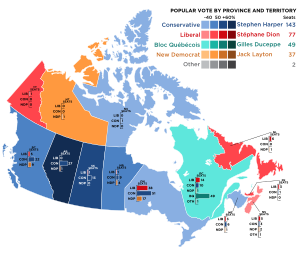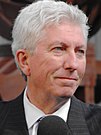2008 Canadian federal election
|
|
||||||||||||||||||||||||||||||||||||||||||||||||||||||||||||||||||||||||||||||||||||||||||||||||
|---|---|---|---|---|---|---|---|---|---|---|---|---|---|---|---|---|---|---|---|---|---|---|---|---|---|---|---|---|---|---|---|---|---|---|---|---|---|---|---|---|---|---|---|---|---|---|---|---|---|---|---|---|---|---|---|---|---|---|---|---|---|---|---|---|---|---|---|---|---|---|---|---|---|---|---|---|---|---|---|---|---|---|---|---|---|---|---|---|---|---|---|---|---|---|---|---|
|
||||||||||||||||||||||||||||||||||||||||||||||||||||||||||||||||||||||||||||||||||||||||||||||||
|
|
||||||||||||||||||||||||||||||||||||||||||||||||||||||||||||||||||||||||||||||||||||||||||||||||
|
308 seats in the House of Commons of Canada 155 seats were needed for a majority |
||||||||||||||||||||||||||||||||||||||||||||||||||||||||||||||||||||||||||||||||||||||||||||||||
| Opinion polls | ||||||||||||||||||||||||||||||||||||||||||||||||||||||||||||||||||||||||||||||||||||||||||||||||
| Turnout | 58.8% ( |
|||||||||||||||||||||||||||||||||||||||||||||||||||||||||||||||||||||||||||||||||||||||||||||||
|
||||||||||||||||||||||||||||||||||||||||||||||||||||||||||||||||||||||||||||||||||||||||||||||||

|
||||||||||||||||||||||||||||||||||||||||||||||||||||||||||||||||||||||||||||||||||||||||||||||||
|
||||||||||||||||||||||||||||||||||||||||||||||||||||||||||||||||||||||||||||||||||||||||||||||||
The 2008 Canadian federal election (more formally, the 40th Canadian General Election) was held on Tuesday, October 14, 2008 to elect members to the House of Commons of Canada of the 40th Canadian Parliament after the previous parliament had been dissolved by the Governor General on September 7, 2008. The election, like the previous one in 2006, yielded a minority government under the Conservative Party of Canada, led by the incumbent Prime Minister, Stephen Harper.
The election call resulted in the cancellation of four federal by-elections that had been scheduled to occur in September.
In 2007, Parliament passed a law fixing federal election dates every four years and scheduling the next election date as October 19, 2009, but the law does not (and constitutionally cannot) limit the powers of the Governor General to dissolve Parliament at any time, such as when opposition parties bring down the government on a vote of confidence. In this election there was no loss of a non-confidence vote, but the Prime Minister asked the Governor General to call an election. The Governor General granted the Prime Minister's request.
64.7% of eligible voters cast ballots in the 2006 federal election. The Conservative Party received the most votes of any single party, with 36% of the vote, and won 124 seats (127 at dissolution). The Liberal Party won fewer seats than in 2006 — 103 seats (96 at dissolution), and 30% of the vote. The Bloc Québécois lost three seats, lowering its total to 51 seats (48 at dissolution), with 10.5% of the vote. The NDP retained its seats held at the dissolution of Parliament, and won 11 more, making its total 29 seats (30 at dissolution), with 17.5% of the vote. The Green Party received 4.5% of the vote, a minimal increase from the previous election, but did not win any seats (1 at dissolution). Independents and other parties constituted 1% of the total vote with one independent winning a seat.
...
Wikipedia





